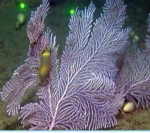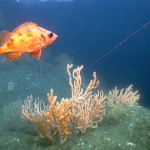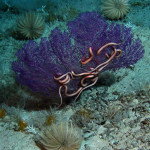This is a special guest post by Ken Stump of the Marine Fish Conservation Network for Deep Sea News, intended to help build awareness about how political action translates into deep-sea research and fisheries management.
New Habitat Authority for Fishery Managers and a Research Program at NOAA Raise the Profile of Deep-Sea Corals, But Will Protection Follow?
Ken Stump, Policy Director
Marine Fish Conservation Network
In 2006, the U.N. General Assembly adopted a resolution calling on States and regional fisheries management organizations to take measures to protect vulnerable deep-sea ecosystems. In the United States, Congress responded by adding new habitat language authorizing U.S. fishery managers to protect deep-sea corals in the reauthorized Magnuson-Stevens Fishery Conservation and Management Act of 2006 (“MSA”). The law also authorized the establishment of a deep-sea coral research and technology program, and requires NOAA’s National Marine Fisheries Service to submit regular reports to Congress describing their progress in conserving deep-sea corals.
This hard-won recognition is a big step forward in the conservation of deep-sea corals and ecosystems, but it remains to be seen if fishery managers will put their new authority to good use. Making good on the promise of greater protection through the regulatory mechanisms of the fishery management councils will require political support, congressional oversight, and sustained program funding in the years ahead.
Here’s a look at some of the challenges to implementation, and how they’re doing so far.
 The 2006 amendments to the MSA’s essential fish habitat (EFH) provisions vested new authority in the regional fishery management councils to designate zones where deep-sea corals are found and restrict the use of destructive gear types within known areas of deep sea coral habitat.
The 2006 amendments to the MSA’s essential fish habitat (EFH) provisions vested new authority in the regional fishery management councils to designate zones where deep-sea corals are found and restrict the use of destructive gear types within known areas of deep sea coral habitat.
It’s important to note that this is a discretionary authority: a fishery management plan (FMP) must identify the EFH of managed fish stocks, but managers are not required to take any particular action to protect EFH such as deep sea coral and sponge habitat. Managers are instructed to minimize adverse effects of fishing “to the extent practicable,” but vested economic interests on the fishery management councils often find it very impracticable to restrict fishing in sensitive habitats – even when it might be in the best long-term interests of sustaining the fishery.
One important difference emphasized by lawmakers during the reauthorization is that deep-sea coral habitat measures do not need to be linked to a determination that the corals comprise essential fish habitat for the relevant fishery. To underscore this point, the reauthorized law includes a new provision authorizing the use of measures to conserve non-target species and habitats, considering the variety of ecological factors affecting fishery populations. In theory, at least, fishery management councils now can protect deep sea corals in their own right as important components of the marine ecosystem.
 In addition, National Standard 9 of the MSA stipulates that managers shall, to the extent practicable (that phrase again), minimize bycatch. NOAA’s new deep-sea corals program intends to compile existing bycatch data from fisheries observer programs and develop guides for the identification of major deep-sea coral species. NOAA’s Northwest Fisheries Science Center (based in Seattle) has already begun to provide training to observers in coral identification.
In addition, National Standard 9 of the MSA stipulates that managers shall, to the extent practicable (that phrase again), minimize bycatch. NOAA’s new deep-sea corals program intends to compile existing bycatch data from fisheries observer programs and develop guides for the identification of major deep-sea coral species. NOAA’s Northwest Fisheries Science Center (based in Seattle) has already begun to provide training to observers in coral identification.
The new habitat authority is intended to promote a proactive approach towards deep-sea coral protection. However, the MSA’s habitat conservation provisions also specify that managers must consider sustainable fishing uses before restrictions are put in place, and additional criteria must be met to justify the closure of an area to all fishing. Anyone advocating the closure of areas to protect vulnerable deep-sea living habitat will bear considerable burden of proof to show adverse effects and may meet with stiff resistance even when compelling scientific evidence of adverse impacts is provided.
Another major change in the law directs the Secretary of Commerce to establish a Deep-Sea Coral Research and Technology Program at NOAA, which is intended to support conservation efforts. This program is “subject to the availability of appropriations,” however, meaning that NOAA must highlight funds in its annual budget request for this activity and Congress must appropriate the money. The Secretary, in consultation with the fishery management councils, is also required to submit biennial reports to Congress on their progress in identifying, monitoring and protecting deep sea corals. The requirement to submit regular reports will help to keep the spotlight on these living habitats and increase the likelihood of future funding.
 In September 2008, NOAA issued a draft deep-sea coral and sponge research plan for public comment. That plan has been revised based on public comments and should be finalized by early fall. If it works as intended, the information provided to fishery managers should make protecting deep-sea corals and other living habitat easier. But the success or failure of the plan and the entire program ultimately hinges on the availability of appropriations from Congress. As history has shown, too many of the MSA’s mandates – including the EFH mandate – have been chronically underfunded.
In September 2008, NOAA issued a draft deep-sea coral and sponge research plan for public comment. That plan has been revised based on public comments and should be finalized by early fall. If it works as intended, the information provided to fishery managers should make protecting deep-sea corals and other living habitat easier. But the success or failure of the plan and the entire program ultimately hinges on the availability of appropriations from Congress. As history has shown, too many of the MSA’s mandates – including the EFH mandate – have been chronically underfunded.
The NOAA Fisheries Fiscal Year 2009 budget included $1.5 million to begin implementation of the Deep-Sea Coral Research and Technology Program, supporting pilot projects by NOAA to better understand the distribution and ecology of deep-sea coral ecosystems. According to Thomas Hourigan, NOAA’s Deep Sea Coral Coordinator, almost two-thirds of the 2009 budget is dedicated to new mapping projects and research in the South Atlantic region, where the South Atlantic Council has proposed to designate large areas of federal waters as deep-sea coral HAPC.
President Obama’s FY 2010 budget seeks an increase of $1 million to $2.5 million, and Hourigan says the increase – which Congress seems likely to approve – will enable the new program to expand its research to the West Coast. But deep-sea research is expensive, and $2.5 million does not go far when it costs several hundred thousand dollars just to lease an ROV for a few weeks of field work.
 What is needed now are champions in Congress who will take up the challenge of securing the resources necessary to implement the mandate and fully fund deep-sea research. Meanwhile conservation advocates are making their case to the fishery management councils in several regions, calling for new habitat protections from destructive bottom-trawl gear in areas of known deep-sea coral and sponge habitat. It’s too early to say if the MSA’s enhanced habitat authority and new deep-sea research program will make their job any easier.
What is needed now are champions in Congress who will take up the challenge of securing the resources necessary to implement the mandate and fully fund deep-sea research. Meanwhile conservation advocates are making their case to the fishery management councils in several regions, calling for new habitat protections from destructive bottom-trawl gear in areas of known deep-sea coral and sponge habitat. It’s too early to say if the MSA’s enhanced habitat authority and new deep-sea research program will make their job any easier.
Images courtesy NOAA Olympic Coast National Marine Sanctuary.
Literature Citations:
i. UN General Assembly Resolution 61/105. http://daccessdds.un.org/doc/UNDOC/GEN/N06/500/73/PDF/N0650073.pdf?OpenElement
ii. Section 105 of the Magnuson-Stevens Reauthorization Act of 2006 (MSRA, Public Law 109-479), amending MSA Sec. 303(b). This provision does not relate to the Coral Reef Conservation Act, which only covers shallow water corals.
iii. See Senate Report 109-229 on S. 2012 (April 4, 2006), p. 11.
iv. MSA Sec. 303(b)(12) (16 U.S.C. 1853(b)(12)).
v. Section 211 amends MSA Title IV (16 U.S.C. 1881 et seq.) by adding a new Sec. 408 (16 U.S.C. 1884).






One of the most exciting initiatives designed to protect deepwater corals using this kind of fisheries authority is nearing completion in the Southeast. The South Atlantic Fishery Management Council has spent more than ten years, working in very close cooperation with world-class scientists, to delineate and now protect virtually all of the known deepwater corals in the four-state region from North Carolina to Florida. This work has developed under the management of the Coral Advisory Panel and the Habitat and Environmental Protection Advisory Panel, which I have chaired throughout this process.
Though it had been known for more than 100 years that corals like Lophelia inhabited water more than 1000 feet deep in the region, it was only in the late 1990s when research was funded to begin characterizing the deep sea in this region. What Dr. Steve Ross (UNC-W) and Dr. John Reed (Harbor Branch) found was nothing short of amazing: nearly 25,000 square miles of ancient coral reefs and pinnacles, some as much as 500 feet tall, with individual corals more than 1000 years old, and some mounds as much as a million years old. Subsequent work has shown them to be biodiversity wonderlands, with new species discovered nearly every dive, and nearly limitless potential for the discovery of compounds new to science of potential pharmaceutical value – a brand-new pharmacopeia!
We now know that deepwater corals are more extensive than shallow-water corals, and this massive coral ecosystem may well turn out to be the world’s largest. More work is needed to evaluate and characterize the seaward zone, where additional extensive reefs will be found.
Most importantly, the South Atlantic Council is poised to protect it all, using (in part) the EFH doctrine Ken described. The proposed Habitat Area of Particular Concern (the highest level of EFH) covers more than 20,000 square miles (and also includes the regions only known methane seep community!). The wrinkle is that deepwater corals are also “fish” under federal law – and protected directly through a coral fishery management plan (which prohibits all harvest). The Council will take a final vote the week of September 15 on the first Comprehensive Ecosystem Based Amendment that amends all of the plans in the region, establishing this protection. The action includes careful design that is truly “win-win,” allowing non-damaging fisheries (e.g. for deepwater shrimp and golden crabs) to continue.
Watch for this important vote!
http://www.safmc.net/HabitatManagement/DeepwaterCorals/LopheliaCommunities/tabid/247/Default.aspx